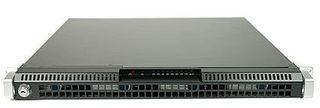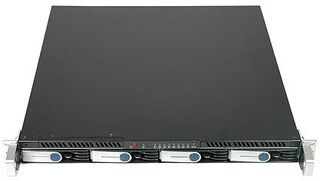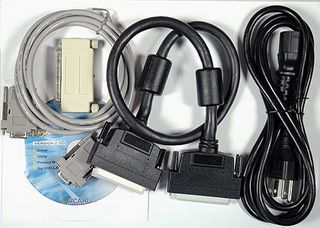Acard's Small Business RAID Appliance
The Big Black Box In Detail

The ARS-3031 is configured with DIP switches on the back of the unit, which are used to select one of the following RAID operation modes: JBOD (just a bunch of drives), RAID 0 (striping), RAID 1 (mirroring), RAID 0+1 (mirroring + striping), RAID 3 (striping with parity) and RAID 5 (striping with rotating parity). You can also specify a hot spare hard drive to rebuild the array if a drive should fail.
During the configuration process, the DIP switches first need to be disabled at the same time. This causes a system reset of the ARS-3031, which is confirmed by three beeps. You can then select the dip switch configuration that will set your preferred RAID mode. The SCSI ID is set using the same dip switch block. An automatic SCSI ID assignment via SCAM, however, did not work during our test.
If there is a problem with the RAID array (which would usually be a broken drive), the ARS-3031 lets you know with a built in alarm. Luckily there is a mute button on the front of the appliance. We recommend attaching the lockable front grid in order to make the drives and the mute button inaccessible, so an alarm will not be accidentally set off.
The SCSI interface uses 68-pin low-voltage differential SCSI cable. Though Acard provides one, its length of approximately 20" is inadequate, because it reduces your operating range and forces you to deploy the ARS-3031 right above or below your host system - unless you go ahead and buy a larger cable, which again can be expensive.
The noise level of 60 db(A) that we measured at a distance of approximately one yard from the device makes the appliance far too noisy for an office environment. Unfortunately, the fans always rotate at their maximum speed, which causes considerable noise and reduces this device's flexibility. Temperature controlled fans would not change the system cost dramatically and would make it possible to run it outside of server rooms if necessary.
We simulated a failed drive by removing one of the array components. As expected, the test array (RAID 5) remained operational. Reinserting the drive triggered an automatic array reconstruction process.



It's nice to see that Acard provides a SCSI terminator to end the SCSI link correctly. Terminators are used to avoid signal reflection.
Stay On the Cutting Edge: Get the Tom's Hardware Newsletter
Get Tom's Hardware's best news and in-depth reviews, straight to your inbox.
Current page: The Big Black Box In Detail
Prev Page 1U RAID Storage In A Box Next Page Hot Swap BaysMost Popular


